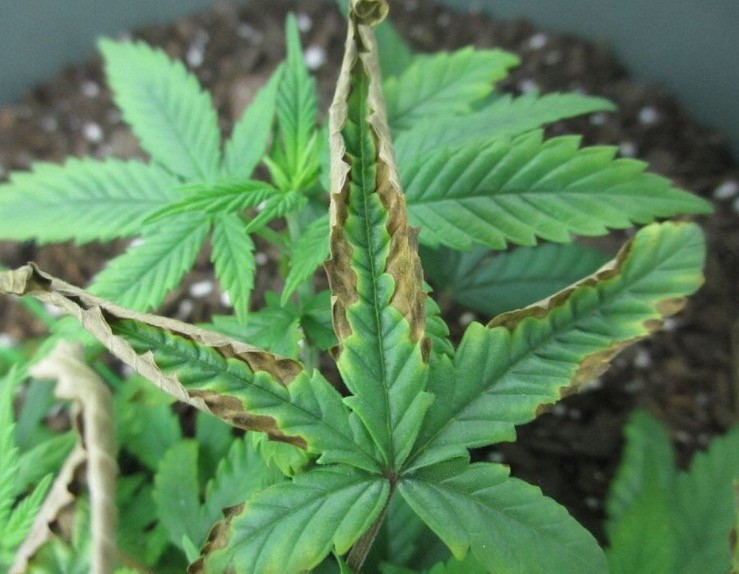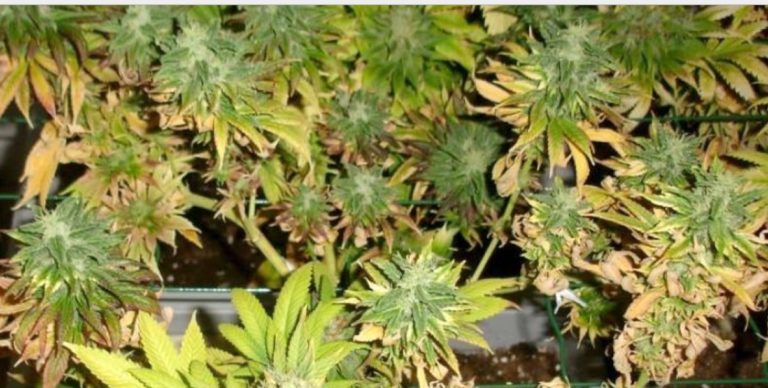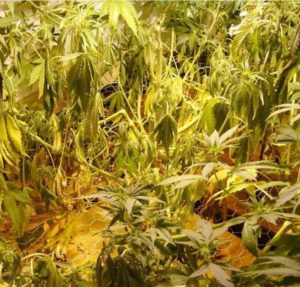Some of the most common problems that can occur with marijuana plants are expressed in the leaves and can be identified as marijuana leaf issues. They could be dying at faster than normal rates, changing color in strange ways, withering, or curling under or over. Generally speaking, leaf death is the result of one of three things: the pH level being off, your watering being too much or too little, or the wrong amount of nutrients (either toxicity or deficiency).
Different problems in your marijuana plant will be evident in a variety of ways on your plant’s leaves, so it’s important to understand how these two things correlate. It takes a bit of detective work to figure it out, but usually, you can safely begin with checking the pH levels and then if that doesn’t work, going from there. Let’s look at the various aspects of unexplained leaf death on your marijuana plants.
How to Check If your leaves are Dying ?
It’s pretty clear when your leaves begin to die off. They first start with discoloration, which can range in color from red to brown to gray to yellow. They may be curling over or under, or simply falling off the plant after discoloring a bit. Once they fall off the plant, they have officially died.
You Want to Heal Sick Leaves ?
Once marijuana leaves have begun to discolor, there is nothing you can do to save that leaf. Besides, it’s not the leaves you should be the most worried about. Always remember that leaf symptoms are just a sign of a deeper problem. To prevent further leaf death, you will need to solve whatever is at the root of the problem.
Remember, the three possible reasons for the death of your leaves are a pH imbalance, a nutrient toxicity or deficiency, or overwatering or underwatering your plants. Think about whether it’s possible that you caused one of those things to be off before doing anything else.
pH imbalance
The first thing you should always check when you see unhealthy leaves is the pH level because this is the most common reason for leaf death. The pH level at the roots of your plants needs to be balanced for your marijuana plants to be able to take in the nutrients.
Sometimes symptoms that look like nutrient deficiencies are actually because the pH level is wrong, therefore “blocking” the nutrients from being absorbed, even when the grower is feeding their plants enough of the right nutrients. For that reason, fixing the pH level will also fix the nutrient deficiency (if that is indeed the problem).
What do you need to know about the pH level and marijuana leaf issues?
Basically, the pH level is the measure the alkaline and the acidity of a solution. The range starts at 0 and goes up through 14. Numbers lower than 7 mean the solution is acidic, while numbers greater than 7 mean the solution is alkaline.
A pH level of 7 indicates that the solution is exactly neutral. Remember, it is just the pH level in the soil near the roots that matters since the roots are what absorb the nutrients and water that you feed your marijuana plants. The pH level doesn’t always need to be exactly perfect, but it should be around the right level to ensure healthy soil pH.

In fact, some pH level fluctuation helps maintain your plant’s ability to absorb different types of nutrients at different rates, improving the overall health of your marijuana plant and helping to avoid marijuana leaf issues. The key is to always maintain and manage the pH level of the soil at your plants’ roots. Do this by testing the solution of nutrients and water before feeding it to your plants. This is quite easy to maintain with pH Up/Down. Keep adjusting and testing until the pH level is right.
Some people prefer to use more natural means of adjusting the pH level. You can lower the pH level by using vinegar, and you can raise the pH level by whisking the water (and therefore adding oxygen). You can also mix dolomite lime into the soil to bring up the pH level (and also add magnesium and calcium).
Remember, a healthy pH level is between 6 and 7. Problems arise if the pH level leaves these bounds. Also, a range between 5.5 and 6.5 is better if you are growing your marijuana plants hydroponically. More about pH in my free marijuana grow bible at this link.
Adjusting the solution that you are about to feed to your marijuana plants’ roots is not the only way to get the pH level fixed at the root level. You can also test the water that comes out from the bottom of the pots (if your plants are potted) — that will help you know what the pH level is down at your roots. If the pH level changes significantly from when you feed it to your plants to when it comes out the bottom, you know there is some pH-related thing going on.
Flushing the system is a good way to balance out the pH level and avoid this these types of marijuana leaf issues. Simply water the plant with pH-balanced water three times (or all at once with three times the normal amount of water), and then resume normal feeding. Keep an eye on the pH levels immediately after that as well, so you know whether it worked or not. Some growers flush their plants on a regular basis to ensure that there is no buildup.
Over watering or Under watering.
If you’ve already addressed the pH level issue and know that’s not what is causing the problems in your marijuana plant’s leaves, then the next thing you need to do is consider the possibility of over watering or under watering. The growing medium plays a big part in whether you are over watering or under watering. For example, coco coir or other soil less media could cause a drainage issue rather than it being the fault of your watering routine.
It’s a good rule of thumb to have a fifth of the water you put in come out from the bottom of the pots your plants are growing in. Once this has been done, you should wait until the top inch or so is dry before you water again. Poking your finger into the soil until the first knuckle is a good way to check if the top layer is dry enough.
Nutrient problems
Nutrient deficiencies are are a tougher type of marijuana leaf issues. Before you consider that, be sure to check that it isn’t a pH imbalance or an improper watering problem. Once you have crossed both of those off your list, you can know that a nutrient toxicity or deficiency is the problem.

nutrient problems
Each nutrient has its own symptoms, so it’s important to do the proper amount of research to establish which nutrient is causing marijuana leaf issues. Then you can solve the problem without too much trouble, as long as it’s not too late.



